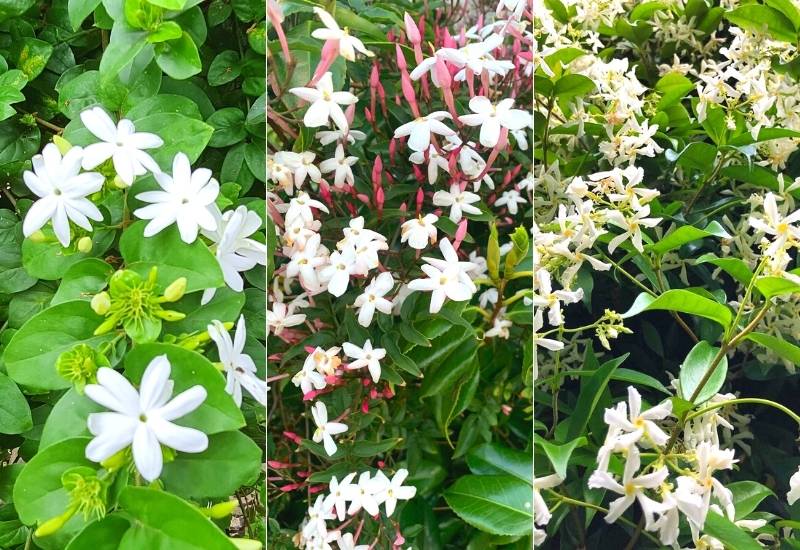
Jasmine is a genus of plants famous for their fragrant flowers and glossy little leaves. It originates from Eurasia and Oceania, but most of us see it as an “Oriental” plant. We also think of it as a white flower, but there are also yellow, pink, blue and variegated varieties.
It is a very generous plant with massive blooms. This makes it ideal for sweet smelling and vibrant gardens and patios. But how many types of jasmine are there?
The genus Jasminum has 200 different species, but all jasmines can be divided into two main groups: vines and shrubs. Within each group, there are species with different qualities and habits. For example, some are evergreen, others are deciduous.
It’s strange, isn’t it? Many people think they “know jasmine” but they only know one variety, usually Jasminum officinale. You are about to find out that this is not so.
You willed that they can have different colors, growing habits, sizes, flower shapes. And we have grouped them into vines and shrubs to make your choice easier!
Read to learn more about the Intensely fragrant jasmine plant varieties and their characteristics, including flower types and growth habit.
Some Facts About Jasmine
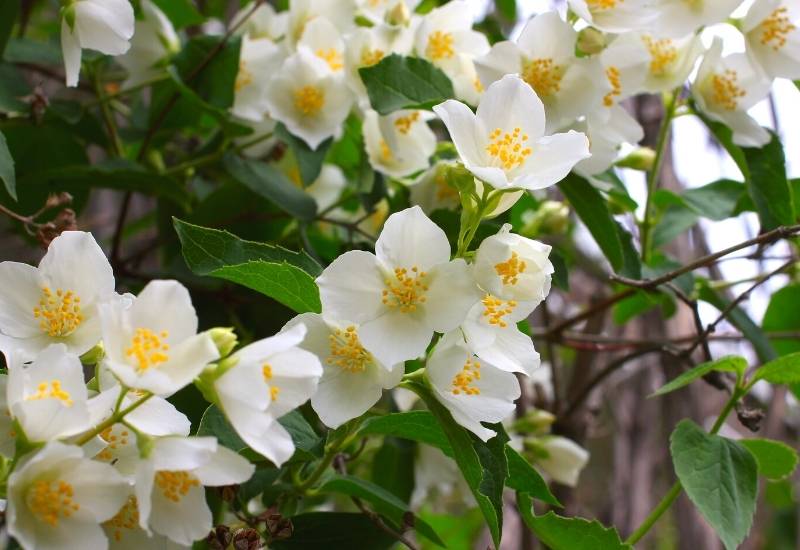
Jasmine come from the Jasminum, Oleaceae (olive) family —a large group that includes more than 200 species of fragrant-flowering shrubs and vines.
Each species has clear differences from the others. The differences can be in the flower shape, color, even smell or in the way the plant grows.
For example, Jasminum elongatum has 7 petals in each flower, while most species have 5. Italian Jasmine (Jasminum humile) has yellow flowers, but most species are white.
The fragrance of jasmine flowers has made this plant famous. It is grown both ornamentally and to extract its fragrance. But even here there is a myth; not all jasmine plants smell the same.
They all have a clear aroma, but some are stronger, some a bit weaker, and some even have a lemon twist, like Jasminum azoricum. Experts can tell the differences between the scents of different species.
Many jasmine varieties come from India, but there are species from Oceania and all over Eurasia. What is more, some varieties have become naturalized around the Mediterranean.
Jasmines have similar soil requirements. They all want well drained and loam rich soil. They can grow in containers too, and the ideal potting mix is peat moss (or substitute), sand and generic potting soil in 1:1:1 parts.
12 Types Of Jasmine Shrubs And Vines for Your Garden
And of course, jasmines can be vines, shrubs or even ground covers. This is a key distinction when you choose a plant, of course. Let’s see why straight away.
Jasmine Vines
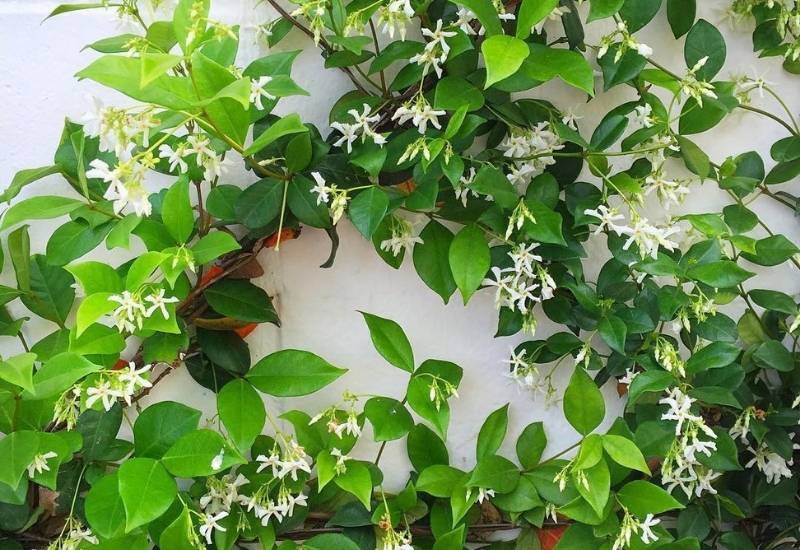
Many jasmine species are vines. But this does not mean that they all grow the same way! Jasminum dichotomum, or gold coast jasmine, for example, is a climber, while Jasminum didymum is a scrambling vine.
Then again, there are differences in size, flower shape and color etc. Some are massive too! have seen jasmine vines climb all the way to the third or fourth storey of a building!
If you choose a vining jasmine, you will have to give it support. People like to grow them on fences and trellises. But as I said, even a wall can do! These vines are often used to “limit” gardens, as hedges, or to cover buildings etc.
One thing is sure though; you have a great choice!
Here are some popular varieties of jasmine vines, sure to make a fragrant addition for your garden.
1: Common Jasmine (Jasminum officinale)
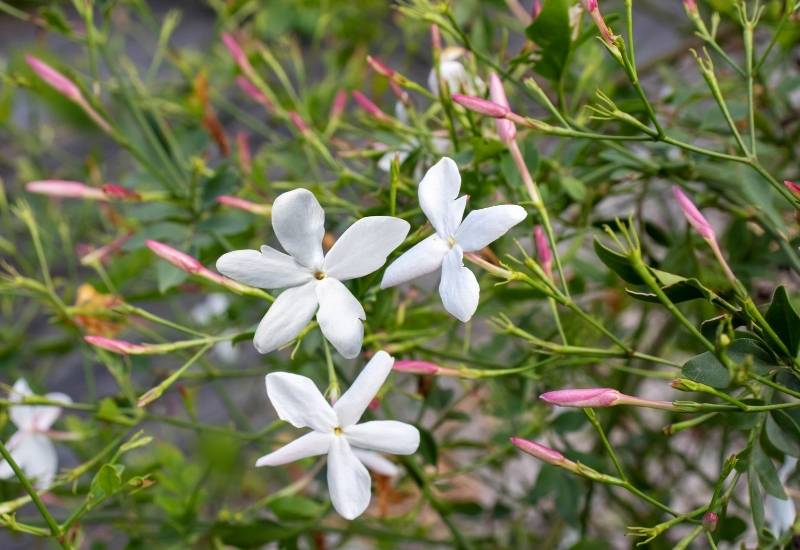
Common jasmine or poet’s jasmine is one of the most popular varieties all over the world. It has been cultivated for millennia.
So long in fact that we don’t know when Humans started growing it! This sun-loving perennial vine has pinnate glossy and dark green leaves.
Once a year, between spring and summer, it blossoms with a sea of intoxicating white flowers. These are small and have five petals, and you can smell them from a distance.
It is a semi deciduous plant, which means that it will drop its leaves in most places, but not in hot countries. It is a twining vine, it wraps itself around its support.
Poet’s jasmine is one of the varieties we grow both for its flowers and to harness its fragrance. In temperate countries, you’d better grow it in a container.
2: Pink Jasmine (Jasminum polyanthum)
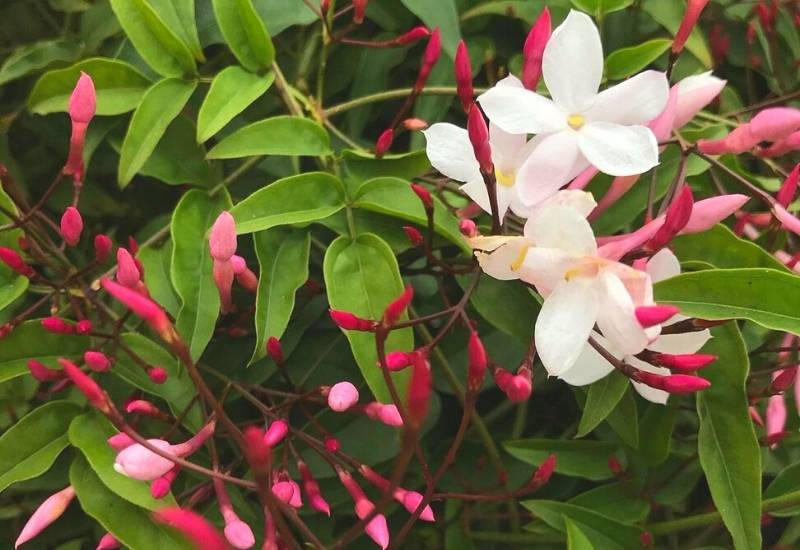
Pink jasmine or many-flowered jasmine is a spectacular Chinese species with polychromatic flowers. The buds in fact, are purple pink, on the magenta side.
When the flowers open, however, they tend to be white. But they retain a pale pink “undershade”. This makes them really stunning and unique. No need to say that the massive blooms are very fragrant – heady even!
It is a strong, evergreen twining vine. It grows quite fast and it is common in the USA and Europe as a houseplant.
So, if you need a jasmine variety which is green all year round and which gives you early results, pink jasmine is just perfect. It won the Award of Garden Merit by the Royal Horticultural Society in 1993.
3: Angel Wing Jasmine (Jasminum nitidum)
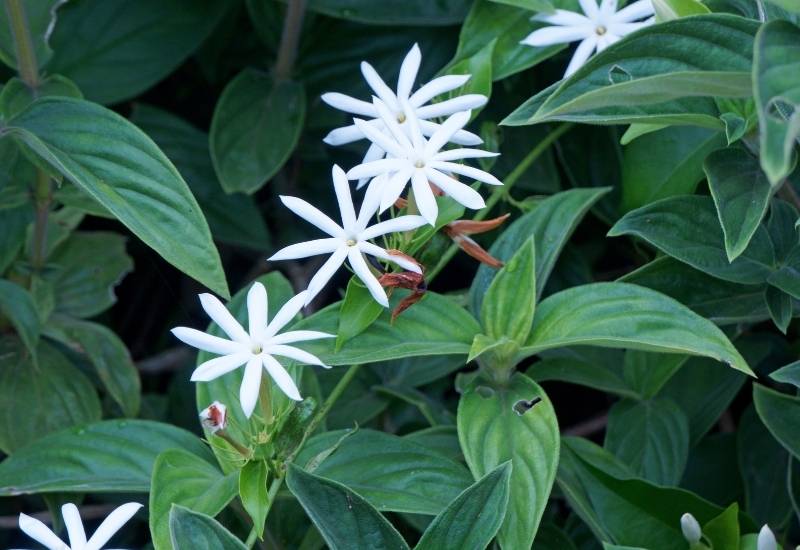
Angel wing jasmine is special because the petals are very long and narrow. This gives it a unique look. They are actually larger than the average jasmine flower.
On top of this, they are white but they have purplish undersides. They look a bit like snow flakes on the decorative foliage. In fact the leaves are pointed and sculptural.
Angel wing jasmine is an evergreen scrambling vine, and it has a shrubby appearance. For this reason, you can train it on supports if you want the climbing look.
But you can also use it for hanging baskets where it will have a trailing effect. Finally. You can grow it as ground cover too!
4: Stiff Jasmine (Jasminum volubile)
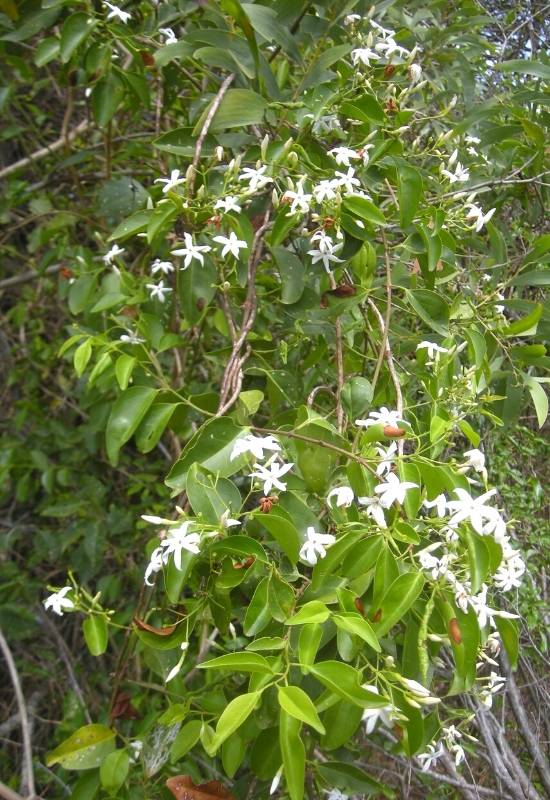
Stiff jasmine is a typical rainforest creeper from Australia. It has egg shaped leaves with clearly raised veins, emerald green in color.
The flowers are star shaped and white, quite typical of jasmine blooms. This plant is very attractive because of the hanging branches, which partly trail from the main ones and float in the wind.
It is a creeper or scrambling vine but you can prune it and keep is as a shrub as well. This can be quite handy if you want an eclectic jasmine plant in your garden.
5: Royal Jasmine (Jasminum rex)
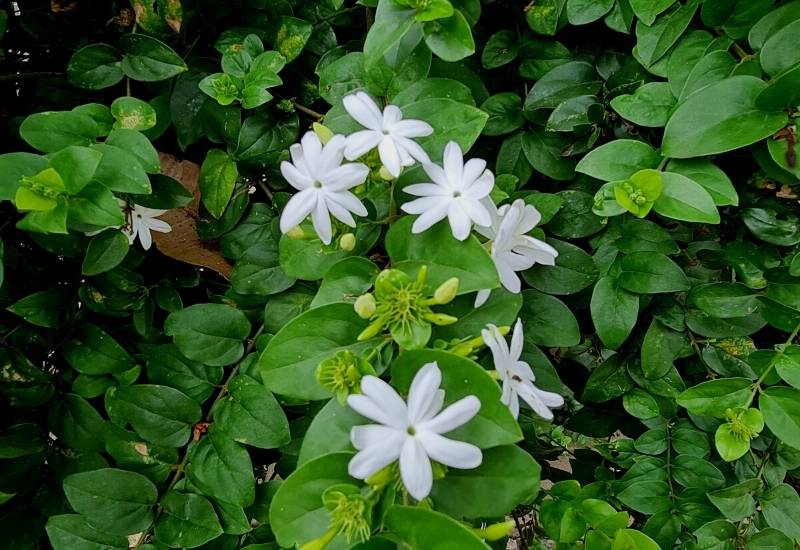
Royal jasmine has the largest flowers of all jasmine varieties. They are white and they can reach 3 inches in diameter (7.5 cm).
They too come in large clusters, but they are not famous for their fragrance. Still, it is the variety you will want for large blooms… Oddly enough it also blossoms at a strange time for jasmine: fall and winter. And you can eat them as well!
It is a strong, evergreen climbing vines, which can grow fast and vigorously once established. You can also train it as a shrub, though over e fence or arching over a gate, the effect is striking!
Shrub Jasmine Varieties
Jasmine shrubs will not put on that massive display you will see all over the mediterranean, with whole walls smelling like heaven… But they will still bloom very generously. And they do have many advantages… Let’s see…
To start with, have you noticed that jasmines are not cold hardy? They grow perfectly well on the coasts of the Mediterranean, but most US and Canadian people live in much colder climates. You have seen that there are no jasmines that survive outdoors in temperate regions.
And a shrub jasmine varieties are easier to grow in containers than a climber! This is why many of the jasmine varieties grown in the USA are shrubs, and not vines.
Then again, you may not have all that “room head” you need to grow a tall vine. Or maybe you just have a small garden or balcony? What is more, shrub varieties can be adapted as houseplants…
So, if you love jasmine but you can’t afford to grow a big vine, here are the best shrub varieties for you!
6: Italian Jasmine (Jasminum humile)
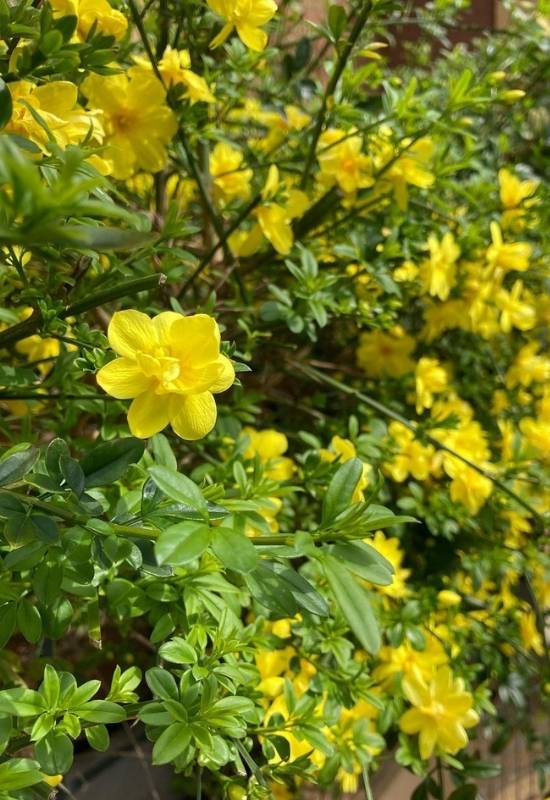
Italian jasmine is a favorite shrub variety with gardeners all over the world. It has beautiful yellow drooping flowers.
These flowers have five petals at the end of a tubular part, which is quite evident given the bright canary color. Each cluster usually has six flowers.
Thus, the flowers are more scattered and sparse compared with other varieties, but they too have a strong scent.
The leaves are pinnate and glossy green, and they may or may not stay on the branches also in winter, according to the climate.
In fact, this shrub is a semi evergreen. It is ideal for patios, terraces and large container planting.
7: Arabian Jasmine (Jasminum sambac)
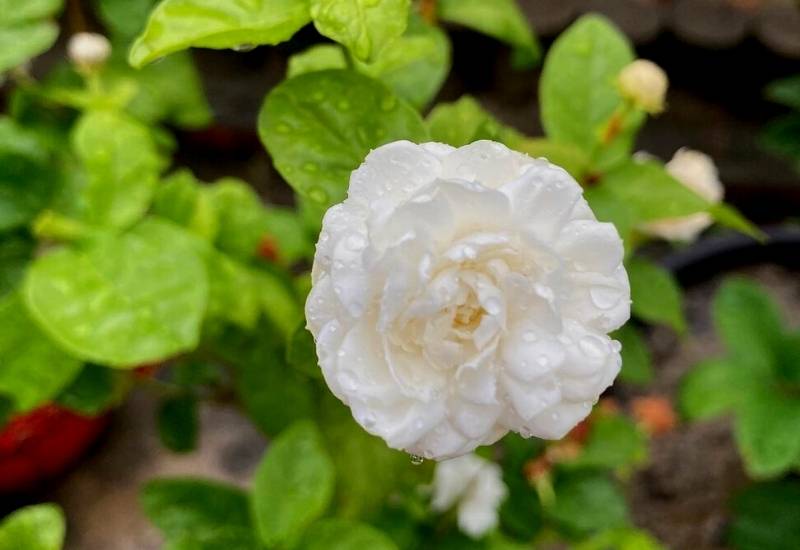
Arabian jasmine is a wonderful medium sized bush. Some varieties and cultivars have double flowers., for example ‘Grand Duke of Tuscany’ and ‘Arabian Nights’.
So far, all the jasmine varieties we have seen have single flowers, so, Arabian jasmine has a different look.
They have two rows of five candid white petals with a very small opening in the middle. The bloom is not very dense but it has a strong scent.
The leaves of this shrub are rather unusual for a jasmine; they are ovate and they have clear veins. And if you choose this shrub variety for your garden, it will blossom sporadically throughout the year!
8: Wild Jasmine (Jasminum fruticans)
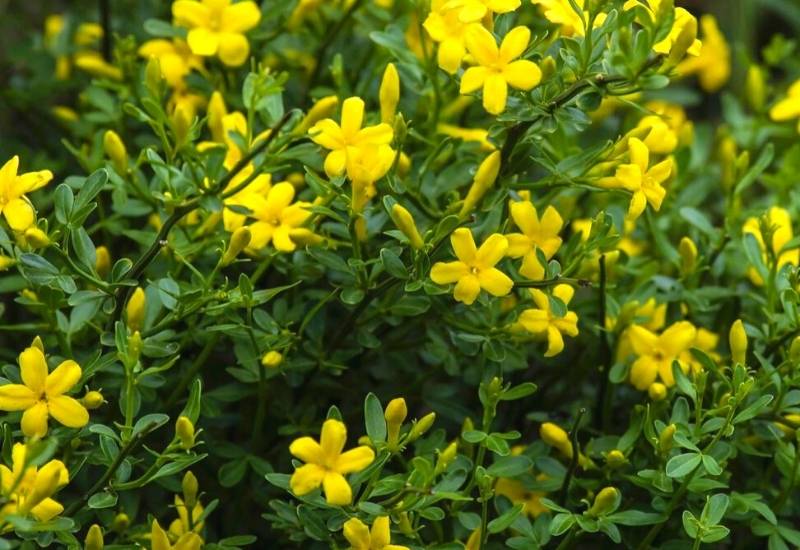
Wild jasmine is a very sweet looking shrub variety. The flowers are bright yellow and they come in small clusters. They will start in spring and keep blossoming in summer too.
They have very rounded petals, which set this variety apart. And the leaves too are very thick, waxy and with rounded tips.
This is a sweet looking but also energetic shrub. The yellow flowers look very vibrant against the dark green foliage. It is ideal for gardens that want to look both soft and energetic.
9: Star Jasmine (Jasminum multiflorum)
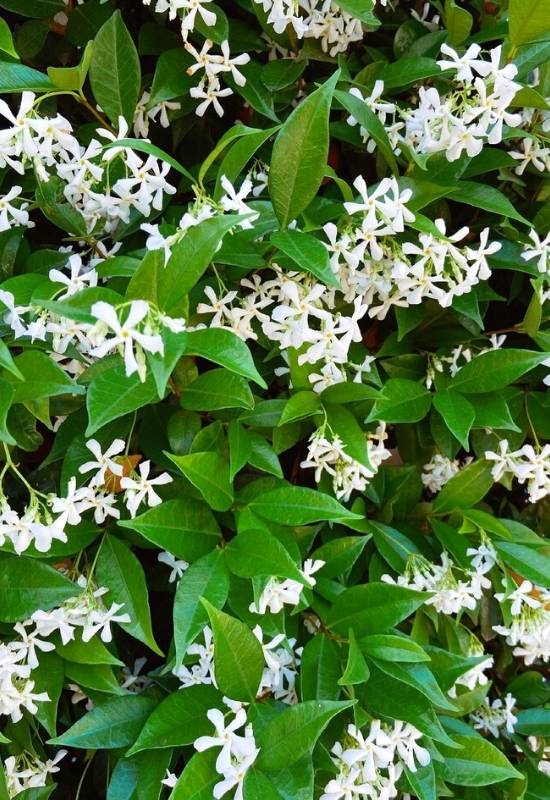
Star jasmine is a decorative scrambling shrub with very unusual flowers. The name gives it away: they are star shaped with 7 petals instead of the usual 5 in other species of jasmine.
But there is more: star jasmine does not have fragrant flowers! On the other hand, the glossy emerald green foliage is quite attractive.
It has become naturalized in Central America, in the West Indies and even in Florida. It is an ideal garden plant or also for containers, patios or large terraces.
It can be trained as a vine as well. Leave it to its own device and it will form spreading and fluffy shrubs with flowers appearing on and off all year round.
10: Primrose Jasmine (Jasminum mesnyi)
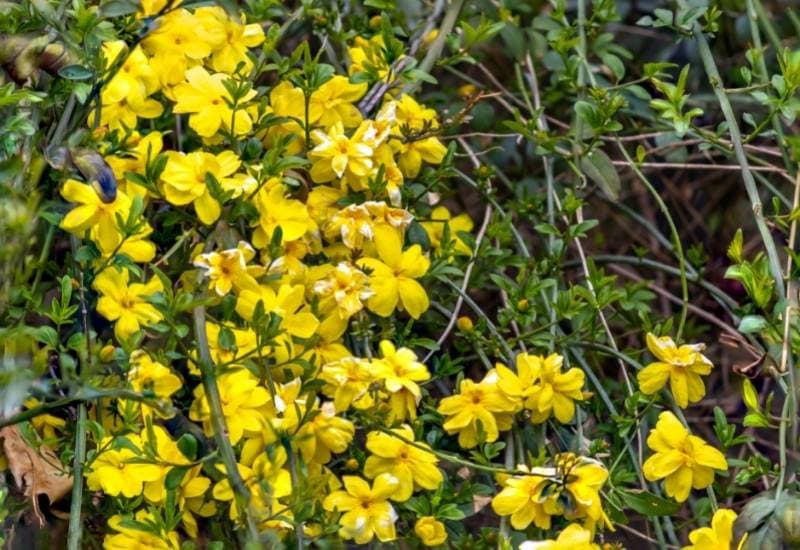
Primrose jasmine forms open and sprawling shrubs with lovely yellow flowers. The flower heads are actually quite large for a jasmine plant, and they form small clusters all over the foliage.
This has oval shaped three pinnate leaves, of a fairly light fern shade. The flowers will start in early spring and they will last for a few weeks.
Its large and showy blooms make it ideal for a garden which likes bold statements. It is less of a “background plant” like many jasmine plants are, and more of a protagonist. It is also a fairly small shrub, so excellent for patios and modest spaces.
11: Winter Jasmine (Jasminun nudiflorum)
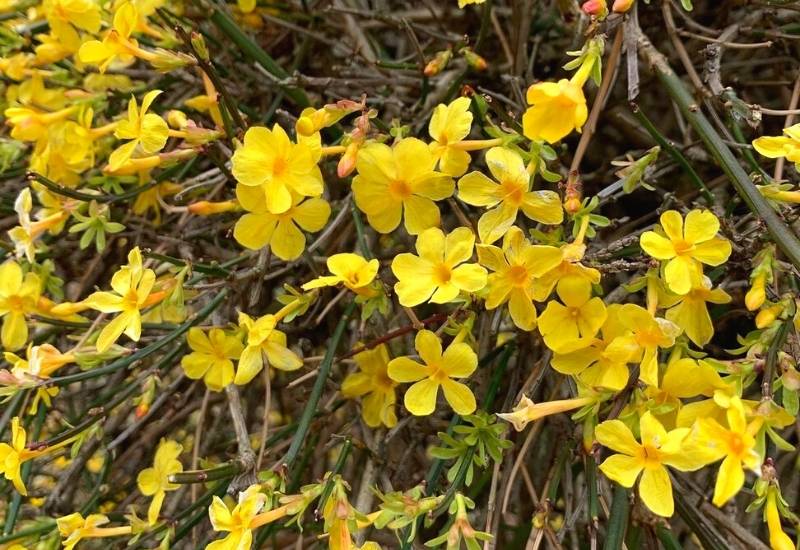
Winter jasmine is another original shrub variety of this genus. Why? To start with, it is much more cold hardy than other varieties.
Next, it will bloom very early in spring, almost in winter. Add the beautiful, bright yellow flowers that reach 1 inch across (2.5 cm). This is quite big for a jasmine flower…
It is a medium sized deciduous bush with long and arching branches. This makes it perfect for containers, on patios and, in full soil, you may well use it as ground cover.
This shrub, like other jasmines, can also be grown as a vine. Once again, jasmines show their differences in subtle ways!
12: Spanish Jasmine (Jasminum grandiflorum)
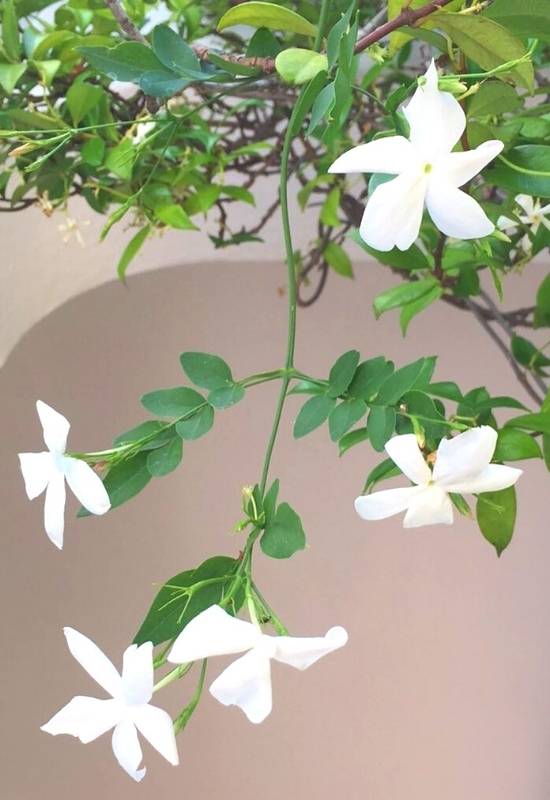
Spanish jasmine has the classic look of this genus. It has white fragrant flowers with 5 petals. It also has the most beautiful, glossy and pinnate leaves.
In fact, it is the shrub that most resembles common jasmine. The flowers appear in cymes and the scent is one of the most sought after in the world.
For this reason, Spanish jasmine is cultivated all over the world. It is a garden plant of great value, but it is also grown for its amazing fragrance.
On top of this, Spanish jasmine is also a medicinal plant. If you want a classic looking jasmine plant but you cannot grow a vine, Spanish jasmine is the best choice you have!
Debunking Jasmine Myths
If you came to this article convinced that jasmine plants and flowers are all the same, I bet you have changed your mind! Some have yellow flowers, some are pink. Some have a strong fragrance, some don’t. Some are evergreen, some deciduous. Some are bushes, others are vines.
In fact, maybe we should talk about “jasmines” and not “jasmine”!

Written By
Amber Noyes
Amber Noyes was born and raised in a suburban California town, San Mateo. She holds a master’s degree in horticulture from the University of California as well as a BS in Biology from the University of San Francisco. With experience working on an organic farm, water conservation research, farmers’ markets, and plant nursery, she understands what makes plants thrive and how we can better understand the connection between microclimate and plant health. When she’s not on the land, Amber loves informing people of new ideas/things related to gardening, especially organic gardening, houseplants, and growing plants in a small space.

Wonderful educational stuff. Two mistakes:
your “Italian Jasmine” J. humile is indeed a J. mesnyi. J. humile and the widely cult. J. h. var. revolutum with more leaflets (<5-11) have smaller flowers and I don't know if any of them have f. flora plena in cult; your J. multiflorum is indeed Trachelospermum jasminoides – watch the typical Apocynaceae flowers. I would suggest not to write species name capital – at least in botany we cap. only the genus names.